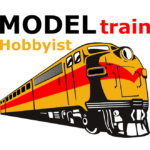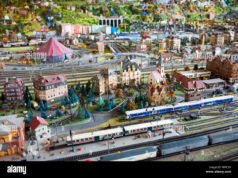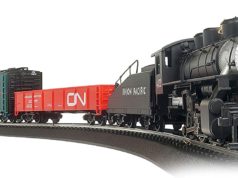You’re satisfied with your track layout, you’ve ran your train and there are no electrical problems, now you want to make the track more realistic by adding ballast. If you don’t know what ballast is, here’s a quick explanation.
If you go to your nearest train track, you will notice the rails and ties are sitting on a bed of rock. The rocks that make up that bed are called ballast. The ballast serves multiple purposes: to give support to the rails and ties, and to drain water from the tracks when it rains.
How To Ballast Train Track
Before you get into the fun of ballasting your track, it is very, very important that you ask yourself a couple of questions first. Are you absolutely sure you are happy with the layout of your tracks? If you are, did you glue your roadbed down and screw your tracks to the roadbed so they can’t move? If you haven’t done this, do it now. There is no point in taking the time to ballast track if it can move around and mess up the hard work you put into it. Once you’ve done this, are all your electrical wires out of the way and working? You want to arrange your wires so that they are not in the way of ballasting or any other part of scenery you may want to do in the future. Also check to make sure everything that needs power has power running to it. This will save you a lot of time and frustration if you take a small amount of time to fix it now.
Ballasting
Okay, now the fun can begin. I suggest you work on a small section of track at a time; around a 2-3 foot section should be enough. You don’t want to do too big of a section because not only will it take more time out of your day, but if you make a mistake it will be easier to redo a small section. Take your ballast, such as Woodland Scenics ballast, and pour it into a small plastic cup. The small cup will allow you to control how much ballast is poured onto the tracks. Evenly pour the ballast down the middle of the track and on the sides of the track.
Next, take a paint brush about the width of the track, and brush away any ballast on the middle of the track that is covering the ties. It doesn’t have to be perfect. It’s okay if a couple of pieces of ballast are on top of the ties, but for the most part you want to have the tops of the ties showing. Do the same thing for the ties on the outside of the rails.
Now that the ballast is cleared away from the tops of the ties in the middle and outside of the track, it’s time to take care of the ballast slope. The ballast will naturally form a slope on top of the roadbed from the track. Brush away any unwanted ballast at the bottom of the slope, and fill-in any thin areas or spots where you can see the roadbed.
Gluing
It’s time to make your work permanent. Take a spray bottle filled with regular Isopropyl alcohol and spray the ballasted area. You need to do this first before gluing in order to break the surface tension of the ballast. If you were to try and glue the ballast without breaking the surface tension, the glue would bead up into balls, like water on an oily surface, and run down the slope causing a mess. By breaking the surface tension, the glue would then be able to soak into the ballast and bind it together once it dries.
After spraying the ballast with the Isopropyl alcohol, take another spray bottle filled with a 50/50 mixture of white glue and warm water, or you can use Woodland Scenics cement adhesive. Set the spray bottle so you get a stream rather than a mist. Spray the ballast on the sides of the track first; don’t worry about the ballast in the middle of the track, you will come back to that. You want to make sure to soak the ballast with the glue mixture, it’s better to do too much than not enough.
Now you can take care of the ballast in the middle of the track. Take an eyedropper filled with the glue mixture and drop a couple of drops of glue in the space between the ties. This is pretty time consuming, but it’s okay because you’re not doing a big section, right? Again it’s better to use too much glue than not enough.
Clean Up
The fun part is over, now it’s time to clean up. By the time you finish gluing the ballast in the middle of the track; the excess glue on the ballast slope should have drained to the bottom, and left small puddles. Take a paper towel, and dab it in the puddles in order to soak up the glue. Also check the tops of the ties for any drops of glue and wipe those up.
Next, clean the rails using whatever solvent you usually use. For ideas, you can read the article on How to Clean Model Railroad Track. Once you have cleaned up excess glue, and cleaned the rails, you’re almost done. Now it’s time to wait. The glue will take several hours to dry, and I recommend letting it dry overnight. The next day, take a vacuum cleaner and vacuum any loose ballast that didn’t want to stay put.
Congratulations, you are finished. Your track is ballasted and it’s looking like the prototype. Now you can continue adding more scenery or start to weather the ballast with traces of oil and small grass that grows between the ballast. Happy railroading!






